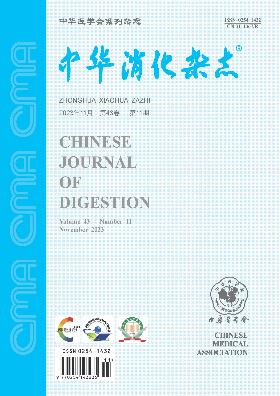Mechanism of microRNA-182 targeting and regulating forkhead box transcription factor 2 to promote the invasion, metastasis and angiogenesis of hepatocellular carcinoma
引用次数: 0
Abstract
Objective To investigate the expression of miRNA-182 in hepatocellular carcinoma (HCC) cell lines and tissues, to verify the targeted regulation relationship between miRNA-182 and forkhead box transcription factor 2 (FOXF2) and to explore whether miRNA-182 can promote the invasion, metastasis and angiogenesis of HCC by targeting FOXF2. Methods From January to October 2017, a total of 41 patients with primary HCC admitting to Cancer Hospital Affiliated to Zhengzhou University and receiving operation were enrolled. The expression of miRNA-182 in tumor tissues and normal paracancerous tissues was detected by quantitative real-time fluorescence polymerase chain reaction (qRT-PCR). The effects of overexpression of miRNR-182 and FOXF2 on invasion and metastasis of HCC were detected by Transwell transfer experiment and the Boyden invasion experiment. The effects of miRNA-182 and FOXF2 on angiogenesis of HCC were determinded by in vitro angiogenesis experiments. The targeted regulation relationship between miRNA-182 and FOXF2 was investigated by dual luciferase reporter gene. The expression of FOXF2 at mRNA and protein level after miRNA-182 and miRNA-182 scramble transfection was detected by qRT-PCR and Western blotting method. T test was performed for statistical analysis. Results The expression in miRNA-182 in HCC tissue was higher than that in normal tissues adjacent to cancer (5.41±1.72 vs. 1.80±0.76), and the difference was statistically significant (t=-5.764, P<0.01). The results of Transwell transfer experiment and the Boyden invasion experiment showed that the number of cells passing through the membrane of the small chamber of miRNA-182 over-expression group was higher than that of miRNA-182 scramble group (85.65±4.86 vs. 31.43±2.41, 55.34±5.66 vs. 19.13±2.12), the number of cells passing through the membrane of the small chamber of miRNA-182+ FOXF2 over expression group was less than that of simple miRNA-182 over expression group (11.21±3.16 vs. 31.43±2.41, 8.67±2.83 vs. 19.13±2.12), and the differences were statistically significant (t=15.110, 9.220, 5.443 and 4.410; all P<0.05). The activity of luciferase of wild FOXF2 and miRNA-182 cotransfection group was lower than that of miRNA-182 scramble group (0.43±0.10 vs. 0.97±0.05), and the difference was statistically significant (t=8.042, P=0.012). However the activity of luciferase of mutated FOXF2 and miRNA-182 cotransfection group was higher than that of miRNA-182 scramble group (0.97±0.47 vs. 1.06±0.52), and the difference was not statistically significant (t=0.934, P=0.402). The results of in vitro angiogenesis experiments demonstrated that the number of constituent vessels in miRNA-182 over expression group was higher than that in miRNA-182 scramble group (14.27±1.77 vs. 5.91±1.42), and after FOXF2 over-expressing plasmids cotransfected, the angiogenesis ability restored (1.78±0.71 vs. 14.27±1.77), and the differences were statistically significant (t=6.530 and 4.570, both P<0.05). The results of Western blotting indicated that the expression level of FOXF2 in miRNA-182 transfection group was lower than that of miRNA-182 scramble group (1.01±0.13 vs. 4.32±0.46), and the difference was statistically significant (t=7.420, P=0.012). The results of qRT-PCR showed that the expression level of FOXF2 mRNA of miRNA-182 transfection group was lower than that in miRNA-182 scramble group (0.591±0.284 vs. 1.534±0.345), and the difference was statistically significant (t=3.465, P=0.014). Conclusion miRNA-182 can promote the invasion and metastasis of HCC cell line by targeting regulation of FOXF2. Key words: Carcinoma, hepatocellular; miRNA-182; FOXF2; Invasion and metastasis; AngiogenesismicroRNA-182靶向调控叉头盒转录因子2促进肝细胞癌侵袭转移及血管生成的机制
目的研究miRNA-182在肝细胞癌(HCC)细胞系和组织中的表达,验证miRNA-182与叉头盒转录因子2 (FOXF2)的靶向调控关系,探讨miRNA-182是否能通过靶向FOXF2促进HCC的侵袭、转移和血管生成。方法选取2017年1 - 10月在郑州大学附属肿瘤医院接受手术治疗的原发性肝癌患者41例。采用实时荧光聚合酶链式反应(qRT-PCR)检测miRNA-182在肿瘤组织和正常癌旁组织中的表达。通过Transwell转移实验和Boyden侵袭实验检测miRNR-182和FOXF2过表达对HCC侵袭转移的影响。通过体外血管生成实验检测miRNA-182和FOXF2对HCC血管生成的影响。通过双荧光素酶报告基因研究miRNA-182与FOXF2的靶向调控关系。采用qRT-PCR和Western blotting方法检测转染miRNA-182和miRNA-182后FOXF2在mRNA和蛋白水平上的表达。采用T检验进行统计学分析。结果miRNA-182在HCC组织中的表达高于癌旁正常组织(5.41±1.72∶1.80±0.76),差异有统计学意义(t=-5.764, P<0.01)。Transwell转移实验和Boyden侵袭实验结果显示,miRNA-182过表达组通过小室膜的细胞数量高于miRNA-182 scramble组(85.65±4.86 vs. 31.43±2.41,55.34±5.66 vs. 19.13±2.12);miRNA-182+ FOXF2过表达组通过小室膜的细胞数少于单纯miRNA-182过表达组(11.21±3.16 vs. 31.43±2.41,8.67±2.83 vs. 19.13±2.12),差异有统计学意义(t=15.110、9.220、5.443、4.410;所有P < 0.05)。野生FOXF2与miRNA-182共转染组荧光素酶活性低于miRNA-182炒炒组(0.43±0.10∶0.97±0.05),差异有统计学意义(t=8.042, P=0.012)。突变FOXF2和miRNA-182共转染组荧光素酶活性高于miRNA-182 scramble组(0.97±0.47比1.06±0.52),差异无统计学意义(t=0.934, P=0.402)。体外血管生成实验结果显示,miRNA-182过表达组血管组成数高于miRNA-182 scramble组(14.27±1.77比5.91±1.42),FOXF2过表达质粒共转染后血管生成能力恢复(1.78±0.71比14.27±1.77),差异有统计学意义(t=6.530、4.570,P均<0.05)。Western blotting结果显示,转染miRNA-182组FOXF2表达水平低于转染miRNA-182组(1.01±0.13∶4.32±0.46),差异有统计学意义(t=7.420, P=0.012)。qRT-PCR结果显示,miRNA-182转染组FOXF2 mRNA表达量低于miRNA-182炒置组(0.591±0.284∶1.534±0.345),差异有统计学意义(t=3.465, P=0.014)。结论miRNA-182可通过调控FOXF2促进肝癌细胞的侵袭转移。关键词:肝癌;肝细胞癌;microrna - 182;FOXF2;侵袭转移;血管生成
本文章由计算机程序翻译,如有差异,请以英文原文为准。
求助全文
约1分钟内获得全文
求助全文

 求助内容:
求助内容: 应助结果提醒方式:
应助结果提醒方式:


